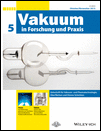Hochleistungsplasmen zur Synthese diamantähnlicher Kohlenstoffschichten
Einfluss verschiedener Prozessgase und HPPMS-Pulsparameter auf die Plasmaeigenschaften
Abstract
deBeschichtungen aus diamantähnlichem Kohlenstoff (diamond-like carbon, DLC) finden aufgrund ihrer vielfältig einstellbaren Eigenschaften, z. B. einer hohen Härte als Verschleißschutz in vielen Anwendungsgebieten Verwendung. Hinsichtlich der Synthese dieser Schichten aktuell das High Power Pulsed/Impulse Magnetron Sputtering (HPPMS/HiPIMS) Gegenstand der Forschung, welches im Gegensatz zu etablierten Verfahren, z. B. der Pulsed Laser Deposition (PLD), glatte Schichten ohne weitere Nachbearbeitungsschritte ermöglicht. Vor Abscheidung der Schichten kann das Beschichtungsplasma in-situ mittels plasma-analytischer Methoden untersucht und ein Prozessfenster zur Schichtsynthese definiert werden. Das Ziel dieser Arbeit war es, ein Prozessfenster mit einer möglichst hohen Anzahl energiereicher Kohlenstoffionen zu bestimmen, die eine Grundvoraussetzung zur Synthese harter DLC-Schichten darstellen. Es wurden die hinsichtlich der Kohlenstoffionisation viel-versprechenden Parameter Prozessgaszusammensetzung und -druck sowie die HPPMS-Pulsparameter variiert, um Parameter für die Schichtsynthese abzuleiten.
Abstract
enHPPMS high-performance plasmas for the deposition of diamond-like carbon coatings Diamond-like carbon (DLC) coatings
Diamond-like carbon (DLC) coatings can be used in many different applications, due to their adjustable properties like hardness as wear reduction. Regarding to the synthesis of these coatings, research is upon the High Power Pulsed/Impulse Magnetron Sputtering (HPPMS/HiPIMS), which in contrast to conventional processes like the Pulsed Laser Deposition (PLD) provides smooth coatings and therefore less postprocessing. Previous to the coating deposition in-situ plasma analysis can be utilized to identify the process parameters. The aim relevantof this work was to identify process parameters which enable to generate a high amount and energy of carbon ions, which are required to synthesize hard DLC coatings. Regarding to the carbon ionization the promising process parameters mixture and pressure of the process gas as well as the HPPMS pulse parameters were varied. Finally, process parameters for the DLC coating deposition could be derived from these investigations.




